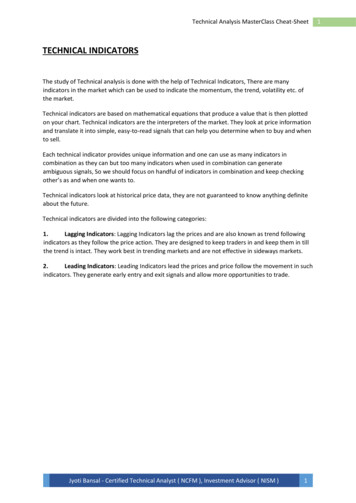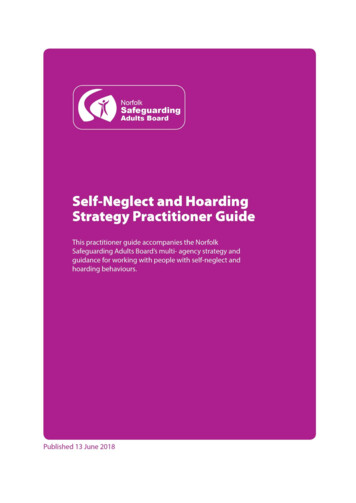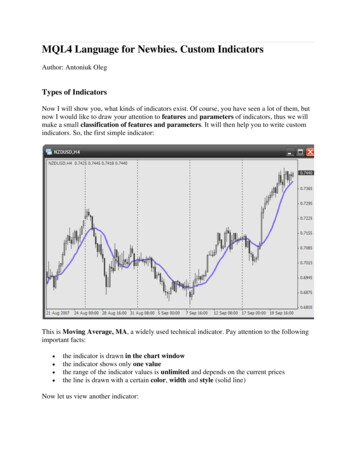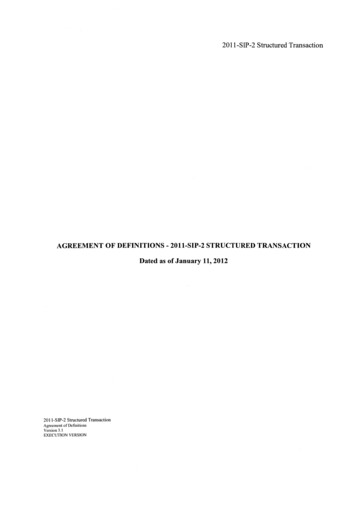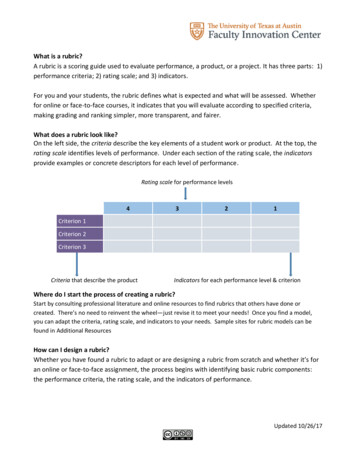
Transcription
What is a rubric?A rubric is a scoring guide used to evaluate performance, a product, or a project. It has three parts: 1)performance criteria; 2) rating scale; and 3) indicators.For you and your students, the rubric defines what is expected and what will be assessed. Whetherfor online or face-to-face courses, it indicates that you will evaluate according to specified criteria,making grading and ranking simpler, more transparent, and fairer.What does a rubric look like?On the left side, the criteria describe the key elements of a student work or product. At the top, therating scale identifies levels of performance. Under each section of the rating scale, the indicatorsprovide examples or concrete descriptors for each level of performance.Rating scale for performance levels4321Criterion 1Criterion 2Criterion 3Criteria that describe the productIndicators for each performance level & criterionWhere do I start the process of creating a rubric?Start by consulting professional literature and online resources to find rubrics that others have done orcreated. There’s no need to reinvent the wheel—just revise it to meet your needs! Once you find a model,you can adapt the criteria, rating scale, and indicators to your needs. Sample sites for rubric models can befound in Additional ResourcesHow can I design a rubric?Whether you have found a rubric to adapt or are designing a rubric from scratch and whether it’s foran online or face-to-face assignment, the process begins with identifying basic rubric components:the performance criteria, the rating scale, and the indicators of performance.Updated 10/26/17
Determine the criteria to assess student work.Figure out what areas really matter to the quality of the work that’s being produced. Whether it’s anessay, a project, a digital story or essay, or a presentation, what do you want evidence of in the finalproduct? List all the possible criteria you might want students to demonstrate in the assignment.Include criteria for the process of creating the product and the quality of the product.Decide which of those criteria are “non-negotiable.” Ideally, your rubric will have three tofive performance criteria. If you’re having a hard time deciding, prioritize the criteria byasking:a. What are the learning outcomes of this unit?b. Which learning outcomes will be listed in the rubric?c. Which skills are essential at competent or proficiency levels for the task or assignmentto be complete?d. How important is the overall completion of the task or project?Develop a rating scale.Rating scales can include either numerical or descriptive labels. Usually, a rating scale consists of aneven number of performance levels. If an odd number is used, the middle level tends to become acatch-all category.1. Show your rating scale beginning on the left with the highest. On the chart below, thehighest level of performance is described on the left. A few possible labels for a four-pointscale include:43215 points3 points1 point0 eds expectationsMeets expectationsProgressingNot there yetSuperiorGoodFairNeeds workExcellentGoodNeeds ImprovementUnacceptableSophisticatedHighly CompetentFairly CompetentNot Yet CompetentDevelop indicators of quality.Define the performance quality of the ideal assessment for each criteria, one at a time. Begin withthe highest level of the scale to define top quality performance. Remember, this is the level that youwant all students to achieve and it should be challenging.Updated 10/26/17
1. Create indicators that are present at all performance levels.2. Make certain there is continuity in the difference between the criteria for exceeds vs. meets,and meets vs. does not meet expectations. The difference between a 2 and a 3 performanceshould not be more than the difference between a 3 and a 4 performance.3. Edit the indicators to ensure that the levels reflect variance in quality and not a shift inimportance of the criteria.4. Make certain that the indicators reflect equal steps along the scale. The difference between4 and 3 should be equivalent to the difference between 3 - 2 and 2 - 1. “Yes, and more,”“Yes,” “Yes, but,” and “No” are ways for the rubric developer to think about how to describeperformance at each scale point.Some common descriptive terms to indicate that progression are listed below.4321TaskrequirementsAllMostSomeVery few ornoneFrequencyAlwaysUsuallySome of thetimeRarely or not atallAccuracyNo errorsFew errorsSome errorsFrequent errorsComprehensibility AlwaysAlmost alwaysGist and mainIsolated bits arecomprehensible comprehensible ideas arecomprehensiblecomprehensibleContent coverage Fully developed, Adequatelyfully supported tedVocabularyRangeVarietyLimitedLacks variety;repetitiveVery limitedBasic,memorized;highly repetitiveBroadHighly petitiveWhat can I consider as I review a rubric?The following questions can help determine if the rubric is effective:1. Are the characteristics of each performance level clear? Will students be able to self-assessby having the descriptors? Will the descriptors give students enough information to knowwhat they need to improve?Updated 10/26/17
2. Does the rubric adequately reflect the range of levels at which students may actuallyperform given tasks?3. Are the criteria at each level defined clear to ensure that scoring is accurate, unbiased, andconsistent? Could several instructors use the rubric and score a student’s performancewithin the same range?4. Does the rubric reflect both process and product?5. Are all criteria equally important, or is one variable stronger than the others?6. Is the language used descriptive for students to determine what is being measured in bothqualitative and quantitative methods.Additional considerations related to rubrics are listed below:1. Rubrics need to be piloted, or field tested, to ensure they are measuring the variable intendedby the designer.2. Rubrics can be discussed with students to create an understanding of expectations.3. Rubrics ensure that scoring is accurate, unbiased, and consistent.4. Rubrics list expectations of student performance that are aligned with the conceptual lessonor unit delivered. Students shouldn’t be expected to do what they haven’t been previouslytaught or shown.Where can I learn more?The following list presents possible (but by no means complete) resources for further learning:The Association of American Colleges and Universities developed VALUE rubrics (Valid Assessment ofLearning in Undergraduate Education. These rubrics are based on Essential Learning Outcomes andfocus on critical thinking. Two AACU websites contain possible rubric models in discipline-specificand general education:http://www.aacu.org/value/rubrics/index p.cfm?CFID 41975853&CFTOKEN arningThe University of Minnesota has created a rich variety of materials on rubrics from creation toapplication. They have included samples of multidisciplinary rubrics as well.Updated 10/26/17
/p 7.htmlThis link presents diverse rubrics designed by Carnegie Mellon and other faculty for essays, projects,presentations, and classroom discussions. Although a particular field of study and assessment typemay not be represented, viewing a rubric for a similar activity may provide ideas on how to divideyour task into criteria and how to describe the varying performance level /teach/rubrics.htmlMany LMS, including Canvas, have tools for creating rubrics online to share with students. Moreinformation can be found on these sites.CANVAS 6-what-is-a-rubric 7-how-do-i-edit-rubric-details 9-how-do-i-add-a-rubric-to-adiscussion 2-how-do-i-add-a-rubric-to-anassignment http://www.youtube.com/watch?v lw4naSjm2BY https://www.youtube.com/watch?v nD IyUM5AUpdated 10/26/17
Usually, a rating scale consists of an even number of performance levels. If an odd number is used, the middle level tends to become a catch-all category. 1. Show your rating scale beginning on the left with the highest. On the chart below, the highest level of performance is described on the left. A few possible labels for a four-point scale .



